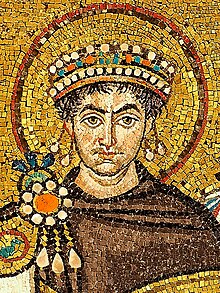Ravenna
Ravèna, Ravêna (Romagnol) | |
|---|---|
Fontanella Piazza del Popolo | |
| Coordinates: 44°24′58″N 12°12′06″E / 44.41611°N 12.20167°E | |
| Country | Italy |
| Region | Emilia-Romagna |
| Province | Ravenna (RA) |
| Frazioni | (subdivisions)
|
| Government | |
| • Mayor | Michele De Pascale (PD) |
| Area | |
| • Total | 652.89 km2 (252.08 sq mi) |
| Elevation | 4 m (13 ft) |
| Population (1 January 2014)[2] | |
| • Total | 158,784 |
| • Density | 240/km2 (630/sq mi) |
| Demonym(s) | Ravennate, Ravennese[3] |
| Time zone | UTC+1 (CET) |
| • Summer (DST) | UTC+2 (CEST) |
| Postal code | 48100 |
| Dialing code | 0544 |
| Patron saint | Saint Apollinaris |
| Saint day | July 23 |
| Website | Official website |
| UNESCO World Heritage Site | |
|---|---|
 Mosaic of the Emperor Justinian I from the Basilica of San Vitale, Ravenna | |
| Criteria | Cultural: i, ii, iii, iv |
| Reference | 788 |
| Inscription | 1996 (20th Session) |
| Area | 1.32 ha |
Ravenna (/rəˈvɛnə/ rə-VEN-ə; Italian: [raˈvenna], also local pronunciation: [raˈvɛn(n)a] ; Romagnol: Ravèna, Ravêna) is the capital city of the Province of Ravenna, in the Emilia-Romagna region of Northern Italy. It was the capital city of the Western Roman Empire during the 5th century until its collapse in 476, after which it served as the capital of the Ostrogothic Kingdom and then the Byzantine Exarchate of Ravenna.[4]
| Year | Pop. | ±% |
|---|---|---|
| 1861 | 55,973 | — |
| 1871 | 58,544 | +4.6% |
| 1881 | 59,696 | +2.0% |
| 1901 | 62,723 | +5.1% |
| 1911 | 69,802 | +11.3% |
| 1921 | 70,502 | +1.0% |
| 1931 | 76,335 | +8.3% |
| 1936 | 80,658 | +5.7% |
| 1951 | 91,248 | +13.1% |
| 1961 | 114,854 | +25.9% |
| 1971 | 131,176 | +14.2% |
| 1981 | 137,375 | +4.7% |
| 1991 | 135,844 | −1.1% |
| 2001 | 134,631 | −0.9% |
| 2011 | 153,740 | +14.2% |
| 2021 | 155,836 | +1.4% |
| Source: ISTAT | ||
Initially settled by the Umbri people, Ravenna came under Roman Republic control in 89 BC. Octavian built the military harbor of Classis at Ravenna, and the city remained an important seaport on the Adriatic until the early Middle Ages. The city prospered under imperial rule. In 401, Western Roman emperor Honorius moved his court from Mediolanum to Ravenna; it then served as capital of the empire for most of the 5th century.
After the fall of the Western Roman Empire, Ravenna became the capital of Odoacer until he was defeated by the Ostrogoth king Theodoric. In 540, Belisarius conquered Ravenna for the Byzantine Empire, and the city became the capital of Byzantine Italy. After a brief Lombard control, Ravenna came under the authority of the Papacy and, save for minor interruptions, remained part of the Papal States until the mid-19th century when it was incorporated into the newly unified Kingdom of Italy.[5]
Although it is an inland city, Ravenna is connected to the Adriatic Sea by the Candiano Canal. It is known for its well-preserved late Roman and Byzantine architecture, with eight buildings comprising the UNESCO World Heritage Site "Early Christian Monuments of Ravenna".[6] Because of the high concentration of mosaics, the city has been associated with workshops and schools teaching mosaics, and is often given titles like the "capital of mosaics".[7][8][9]
- ^ "Superficie di Comuni Province e Regioni italiane al 9 ottobre 2011". Italian National Institute of Statistics. Retrieved 16 March 2019.
- ^ GeoDemo - Istat.it
- ^ Generally speaking, adjectival "Ravenna" and "Ravennate" are more common for most adjectival uses—the Ravenna Cosmography, Ravenna grass, the Ravennate fleet—while "Ravennese" is more common in reference to people. The neologism "Ravennan" is also encountered. The Italian form is ravennate; in Latin, Ravennatus, Ravennatis, and Ravennatensis are all encountered.
- ^ "Storia dell'Esarcato d'Italia". www.homolaicus.com. Retrieved 2024-01-05.
- ^ "Ravenna - Treccani". Treccani (in Italian). Retrieved 2024-01-05.
- ^ "Early Christian Monuments of Ravenna".
- ^ "Day Trip to Ravenna: What to See in Italy's Mosaic Capital". ITALY Magazine. Retrieved 2023-05-18.
- ^ Franceschini |, Giulia (2023-04-24). "Ravenna, the capital of Italian mosaic". L'Italo-Americano – Italian American bilingual news source. Retrieved 2023-05-18.
- ^ Fiorentino, Sara; Chinni, Tania; Vandini, Mariangela (2020-11-01). "Ravenna, its mosaics and the contribution of archaeometry. A systematic reassessment on literature data related to glass tesserae and new considerations". Journal of Cultural Heritage. 46: 335–349. doi:10.1016/j.culher.2020.06.003. hdl:11585/764608. ISSN 1296-2074. S2CID 225764842.









